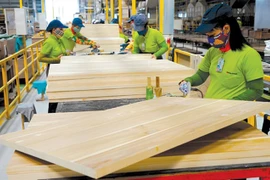Vietnam’s forest coverage rate is set to reach 42-43%,while the forest production value is expected to increase by 5-5%, according tothe forestry development strategy for the 2021-2030 period.
Under the strategy, the country aims to earn 23 – 25 billion USD from exportingforestry products, and grow 1million ha of big timber forests nationwide by 2030 to form sustainable raw material zones for thewood processing industry serving export and domestic consumption.
According to businesses, although the timber supply currently meets over 70% ofthe demand for processing wood for export, the stability and sustainabilityremain low due to the insufficient quality of planted trees.
The Ministry of Agriculture and Rural Development (MARD)’s Forestry Department saidthat localities are facing difficulties in afforestation efforts, particularlyin planting high-quality big timber forests, due to the small-scaleplanning land plots, fragmentation in many areas, and dispersed rather thancontiguous regions.
Due to the scarcity of supply from planted forests, wood processing enterprisesare facing many difficulties in purchasing raw materials.
To address this situation, enterprises are advised to promptlydevelop cooperative development plans along the forestry product value chain, and promotecollaboration models between enterprises and growers granted sustainable forest management certificates in localities.
These are important prerequisites for promoting stable and sustainabledevelopment of the wood industry, thus meeting the demand of themarkets.
Insiders said, to quickly address the shortage of wood materials, there is nobetter solution than developing high-quality production forests and sustainablycertified forests by international and domestic authorised organisations.
Statistics from the Forestry Department showed that the forest area nationwide hasincreased quite rapidly, curently standing at about 14.74 million ha, with plantedforests accounting for 4.57 million ha or 31%, and natural forests marking up 10.17million ha or 69%.
Apart from providing jobs for millions of farminghouseholds, planted forests have become the main source of supply for the woodprocessing industry and exports.
Many localities have focused on developing big timber forests,improving productivity and quality of forests associated with promoting sustainableforest management and increasing the area of certified forests, thus providinglegal and quality materials for processing, and increasing incomes for forestgrowers.
To realise the forestrydevelopment strategy in the 2021-2030 period, the MARD devised several measures in its plan, includingreviewing the land reserves and big timber forests eligible fordevelopment, connecting forest growers with businesses, and promotingsustainable forest management and forest certification.
It will also step up the development of high-yieldand high-quality plantvarieties that meet the market’s demand and are resistant todiseases and adverse environmental conditions to use for afforestation.
Favourable mechanisms and policies such asexempting or reducing land rent and land use tax, supporting investment, andproviding soft loans to attract private resources to developing big timber forests./.





























